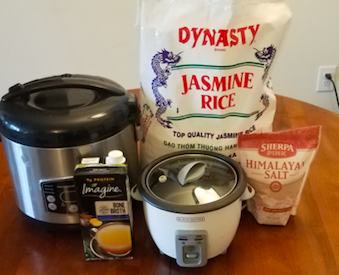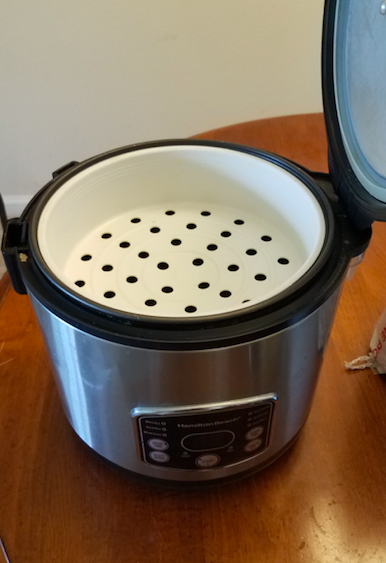Rice is a staple in my diet. I eat it with multiple meals because it is easily digested, carbohydrate dense, and it goes well with every meat. With that, rice can get pretty boring. It does not have much of a taste unless it is paired with salts/spices, sauces, meat juices, etc. Here I will share with you my favorite ways on how I prep my rice.
First, we need to make sure to pick out the best type of rice. You want to find a rice that is easy to cook, digests well, and that has a good nutrient profile. My favorites are Basmati or Jasmine white rice. The first thing that I look for looking for rice is I look that their ingredients list. I want only ONE ingredient on that list. It should read “basamati/jasmine/brown rice”. I DO NOT WANT enriched rice. Enriched rice typically has added iron, niacin, thiamin, and folic acid. I look for a rice that does not have added vitamins and minerals.
I try to stay away from minute rice. Most of the time the nutrient quality is going to be subpar and it will be enriched. I go for the BIG 10-20lb bags of rice because I will only have to buy rice every month or two. If you are tight on time or if you are traveling, the minute rice can be nice. But I would not make it a staple of your diet.
White vs. Brown Rice
Why do I choose white rice over brown rice? That is just a personal choice. I know that I digest white rice better. The only way for you to test is to try different types of rice and see how they feel on your stomach. Eat about a 50g of carbohydrate bolus of one type of rice with NO OTHER FOOD. In 30 minutes how do you feel? Okay how does it feel in an hour? If you feel good and want to eat more, then you found a rice you can digest well!
The fiber content in brown rice is higher but it is still not a great source of fiber. In one cup of brown rice you are only getting 3.5g of fiber. That is about than 10% of your daily value.
Phytic acid is a natural ingredient in brown rice that has been associated with impairing the digestion of the nutrients attached with the brown rice. Whether or not it is true, it doesn’t really matter! Rice is primarily a carbohydrate source. It doesn’t have much nutritional density if it is not paired with meats, vegetables, and spices.
Find a rice that digests well and stick with it.
[thrive_leads id=’8426′]
Cooking Rice
Once you have your rice, rinse it. It takes 10-30 seconds total. Rinse it out a few times. You will see the cloudy solution/sediment flow out.
Get a rice cooker! These things are so cheap and save so much time and mental energy. There are some that can be programmed so when you get home from work/gym the rice is ready. You don’t have to worry about over or under cooking the rice, you don’t have to worry about burning the kitchen down, and you have your food ready when you want it to be ready!
Now that you have your rice drained and your rice cooker ready, we need to talk about how to enhance the nutrient density and taste of the rice. I have three favorite ways to do that.
Rice Cooker + Steamer
I often use a rice cooker that has a steam basket inside, cooking vegetables at the same time. If you steam your vegetables, you are losing a good amount of the water-soluble vitamins inside the vegetables. BUT if you steam them inside a rice cooker the water-soluble vitamins drip from the vegetables into your rice. You can add all sorts of vegetables with some seasoning salt in your steamer basket and the same water that cooks your rice, cooks your vegetables. You don’t need any extra water. It saves time and adds more flavor/nutrients. Rice cookers with steam basket on Amazon.
Himalayan Salt
This is a great way to spice up your rice. If you like the bland taste of rice but want to add a little salt with a higher nutrient profile, this is where to go! Sea salt can be used as well.
Bone Broth
I saved the best one for last! I have been using bone broth for the last few weeks and I LOVE IT. Bone broth is different than chicken broth or chicken stock. Bone broth is made by stewing bones of an animal for 12-48 hours. All the nutrients that are deep inside the bone are released slowly over time. Chicken broth and stock are often cooked with scraps of meat with a shorter cooking time. Bone broth has been all over the health news with its claimed benefits including improving joints, chronic digestive problems, and autoimmune conditions. Bone broth is the known to be the world’s best source of collagen and gelatin. These two nutrients are often used in the digestive and skin health fields. It also naturally has glucosamine and amino acids like glycine and glutamine. Best of all, it tastes good and it is cheap! It costs less than $3 at the grocery store. The sodium content is not too high either. The sodium content seems to be just enough to add some flavor to the rice and improve the way it is cooked. Typically, when I cook my rice using a bone broth I will do half water and half broth. That seems to make the best rice for me.
[thrive_leads id=’8361′]

